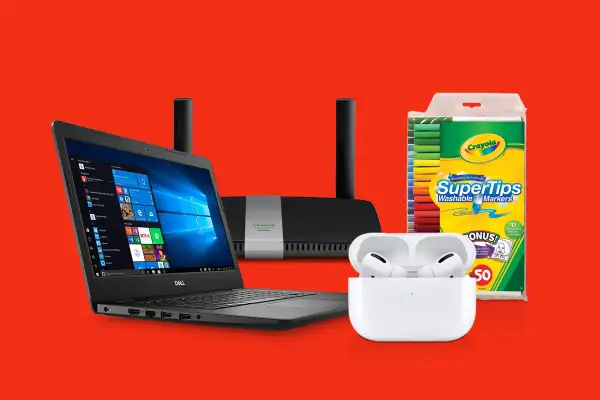Everything Students Need to Be Successful at Distance Learning

Whether your kids are starting the school year off 100% virtually, taking on a hybrid version of learning, or full-on home schooling, it makes sense if you’re at least a little apprehensive about the upcoming semester.
In the spring, families struggled as children and their parents simultaneously spent their days learning and working from home, but luckily summer break has given families and educators more time to figure out the best ways to create a quality learning environment for students. Although Zoom meetings will never replace in-person classes, there are still plenty of tools available to make learning from home a positive experience for everyone involved.
So if your kids are headed back to school from the comfort of the living room again, here the teacher-recommended tools you need for a hassle-free experience:
The Essentials
You can’t expect to have a (somewhat) fruitful remote learning experience without a computer — but choose wisely. You obviously don’t want to break the bank, but it’s important to have something reliable that can last at least a few years and has a good amount of storage space for any projects or programs that come along.
“Stick with what is in your houses’ ecosystem so if you’re a Mac house, get a Mac. If you’re a windows house, get a PC,” says Nicholas Provenzano, a middle school teacher based in Michigan and owner of The Nerdy Teacher, an education consulting business.
Although expensive, the 13-inch Macbook Air is an especially great purchase for teenagers in middle and high school because of their long term durability. Most Macbooks can go for years without needing any major fixes or replacements.
“If you’re buying a device for your freshman, don’t just think about it as a tool for this year only, think about how it’ll support learning years down the road,” says Provenzano.
These ultra-lightweight laptops are also perfect for kids who need to run programs like Adobe Photoshop or Clip Studio for classes or hobbies outside of school due to their larger storage capabilities (available in 256 or 512 gigabytes).
If you’re looking for a laptop that’s less expensive but still high-quality, the Dell Inspiron 14 3000 is a great budget option, especially for younger students who might not need access to additional tools that take up a large amount of storage space.
Focus Better
It’s vital to cut off as much distraction for students while they’re working as possible, especially if there’s multiple other people at home during class time. Not only do students need to be able to easily hear and communicate, but teachers also need to have high-quality equipment so they can be attentive to questions or concerns students might have.
“A good microphone and a good set of headphones can be combined. Airpods do both and are very effective,” says Provenzano.
Airpods Pro are pricey and can easily be lost, which is why they’re best for middle and high school aged students. For elementary-aged children, over-the-ear headphones might be a more comfortable option, like these adjustable Rockpapa I22 Foldable Headphones. Like Airpods, these include a microphone for easy communication, but are less likely to be lost — and come at a much lower price point.
Staying Connected
This spring, many families who previously hadn’t paid too much attention to their home WiFi discovered that working from home together, using Zoom and learning tools at the same time is a recipe for annoying glitches and sudden internet outages. If you and your children will all be at home and working or learning from individual devices for the foreseeable future, it might be time to invest in a better, faster WiFi router.
The Netgear Nighthawk X10 AD7200 is a pricier, but great option for larger families. This high-speed router can get up to 2500 square feet of wireless coverage and can support up to 45 devices at once.
A less-expensive option for smaller families is the Linksys EA6350 Dual-Band WiFi Router. It can cover up to 10 devices and has quick transfer speeds that are great for downloading programs and files necessary for distance learning.
Creative Outlets
Maybe now more than ever, children need creative outlets. It’s important for kids to be able to let loose and have undirected play and opportunities for creative expression, especially when they’re now spending multiple hours a day on a computer or tablet. An inexpensive way to help your children do this is with some good old fashioned crayons, markers, and paper.
Provenzano encourages parents and teachers to ditch worksheets that measure rote memorization, and instead use this time at home to facilitate more self-guided projects and research. The result is that children are more interested in the subject and can work more independently.
“Project-based learning puts the power back in the hands of the student,” says Provenzano. “It might mean answering questions by building a model with legos, making a work of art, or creating their own lesson about the topic you’re teaching.”
But there’s no need to splurge on project supplies — the basic staples that you usually buy for back-to-school will work just fine. So if the markers you keep at home are drying out and the crayons have been whittled down to nubs, it’s a good idea to just grab a new set before the school year starts.
- Crayola Markers
- Crayola Crayons
Easy Planning and Communication
In a household full of different schedules, communication is key.
Children tend to have a difficult time differentiating the boundaries between “work” and “home” when their parents are also supposed to be working from home, according to Yamalis Diaz, PhD, a child psychologist and clinical assistant professor in the Department of Child and Adolescent Psychiatry at NYU Langone Health. The result is that both parents and children have a more difficult time staying on task and getting their respective work done.
“It may be useful for parents to use a visual reminder to let kids know when they can knock and interrupt versus when they have to wait,” says Diaz.
Diaz suggests setting up some type of signal system that allows working parents to silently let their kids know when it is and isn’t an ideal time to talk. If you have your own office space, something like these simple ‘Do Not Disturb’ door hangers can do the trick, but just taping up your own makeshift ‘Stop’ sign will work.
“Using a structured routine is perhaps the most important strategy that parents can use,” says Diaz.
A large, easy to read — and even easier to change — weekly calendar is a must-have when you’re trying to see when everybody has breaks and when they need to be on-task. Plus, it can help parents see when the best moments for their own downtime can be.
According to Diaz, parents are notoriously not-so-good at self-care and planned downtime to reboot and manage their own stress, which in turn can contribute to tension between parents and children.
Finding even 15 minutes each day for some much-needed solitude can help to reset your stress levels before launching back into the new “normal” of distance learning.
More From Money:
The Best Tech for Remote Learning
